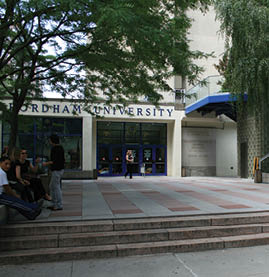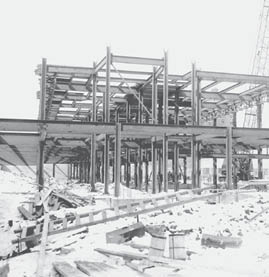Plan to Expand Lincoln Center Campus Awaits Public Hearing
Surrounding Community Voices Criticisms
May 25, 2011

FCLC – Nearly a half of a century ago, after much planning, fundraising and controversy, ground was broken and construction begun on what is now Fordham’s Lincoln Center (LC) campus. Today, the university has new plans to expand the campus and faces new obstacles. The project, also known as the Master Plan, will face its first public hearing on Sept. 10.
“It is critical that educational institutions continue to evolve and grow,” the Rev. Joseph M. McShane, S.J., president of Fordham, said in a statement released in 2005 when the Master Plan was unveiled. “This development permits Fordham to compete on the very highest level, offering the highest caliber education to the students we attract in New York, nationally and worldwide.”
The Department of City Planning (DCP), on behalf of the City Planning Commission (CPC), will hold a public scoping meeting on Sept. 10 on the “Draft Scope of Work for an Environmental Impact Statement” (EIS) to be prepared for the Lincoln Center Master Plan, according to DCP.
According to a 2005 press release by Fordham Public Affairs, the new plan involves adding classroom space, dormitories, a new student center, additional parking, and an expanded library. According to a recent article by The New York Sun, the project also proposes construction of two private condominium towers that will be used to raise revenue. Further details of the Master Plan are not being released by Fordham to the public for the time being.
Members of the public have already voiced criticisms, according to The New York Sun. Local residents fear that the new development would result in a “fortress” that would clash with the scale and character of the neighborhood.
Other residents have criticized the plan to build private condominiums, claiming that Fordham was given the land for sole educational use, according to The New York Sun. Fordham rejects the argument, according to the article. “We’ve been running lots of education programs, graduated thousands of people, and there are no restrictions anymore—we kept our agreement with the city,” Joseph Muriana, associate vice president of government relations, told the New York Sun.

Fordham has had two previous ‘Master Plans,’ said the Rev. Robert R. Grimes, S.J., dean of Fordham College at Lincoln Center (FCLC), the first and the second having been proposed in the 1950s and 1960s. Both plans were only partially carried out, Grimes said.
According to “Up To the Present,” a book written by former Fordham President Rev. Robert I. Gannon, S.J., which chronicles Fordham’s history into the 1960s, Fordham purchased the land between 60th and 62nd streets, and Amsterdam and Columbus avenues, from the city at a discounted price. The land along with the area that is now Lincoln Center for the Performing Arts was part of an urban renewal project headed by the Slum Clearance Committee, chaired by Robert Moses.
According to various newspaper headlines of the 1950s, criticisms were no stranger to Fordham’s plans even then. According to the New York Times, court action was taken by Harris L. Present, then chairman of the New York Council on Housing Relocation Practices, on the notion that the city’s agreement with Fordham violated the federal and state constitutional guarantees of separation of church and state.
“The complaint alleges that Fordham is to receive public aid not only through a land-price knockdown, but also through use of the city’s condemnation power to acquire a site for a midtown campus,” the New York Times reported in 1957.
The case, which had become a national issue, according to the New York Times article, was ultimately taken to the Supreme Court. The Supreme Court declined to consider constitutional objections, and the university, after being forced to delay their plans for nearly a year, resumed their preparations for the project in 1958.
Construction began shortly thereafter in the spring of 1959 and on Nov. 18, 1961, Fordham’s new law school was opened, according to The New York Times. Gannon explains in his book that the original plan consisted of three separate stages, the first being the law school. The second and third stages were not completed as planned, for financial and time related reasons, Grimes said.
According to a press release by Fordham Public Affairs regarding the new Master Plan, the Lincoln Center campus was originally built to accommodate approximately 3,500 students. Approximately 8,000 students are enrolled today.
The plan must undergo the city’s land-use review process which includes approval from the City Planning Commission and the City Council. Despite the criticisms that have surfaced in the community, Grimes said Fordham is “rather confident that the project will be approved.”








